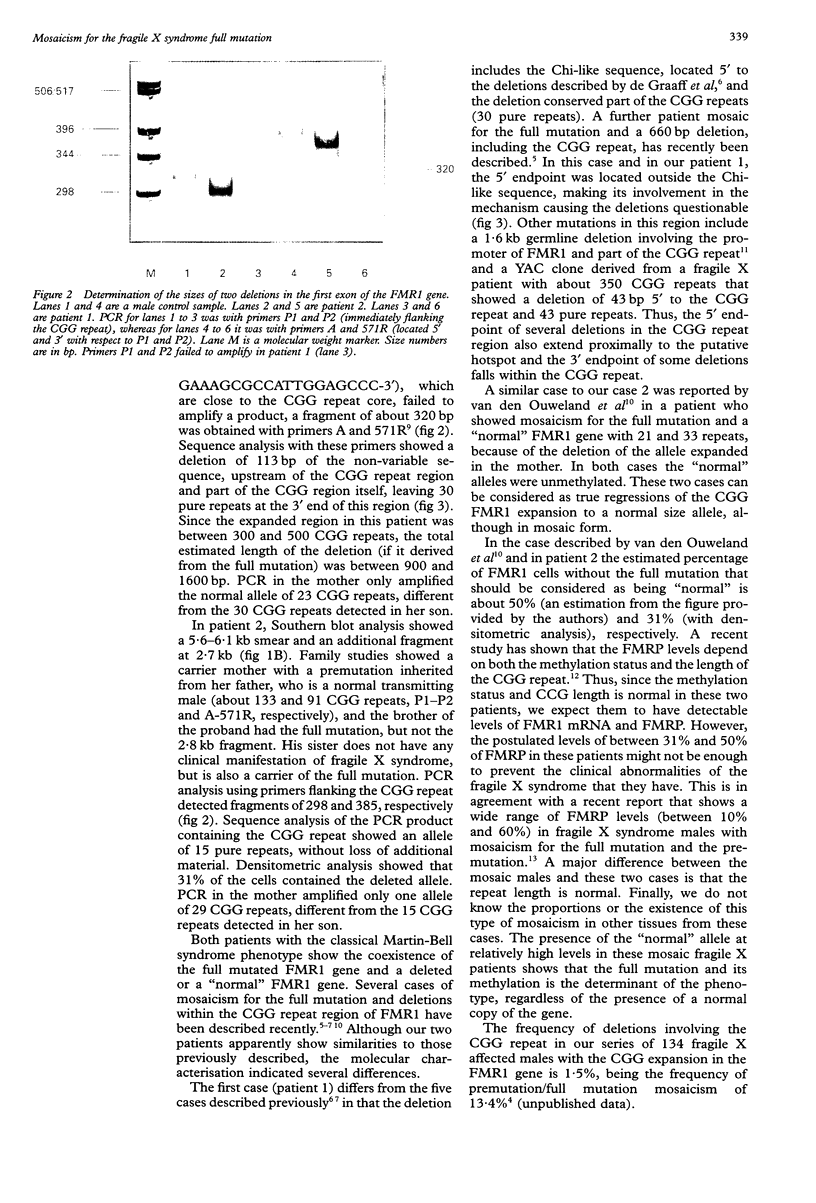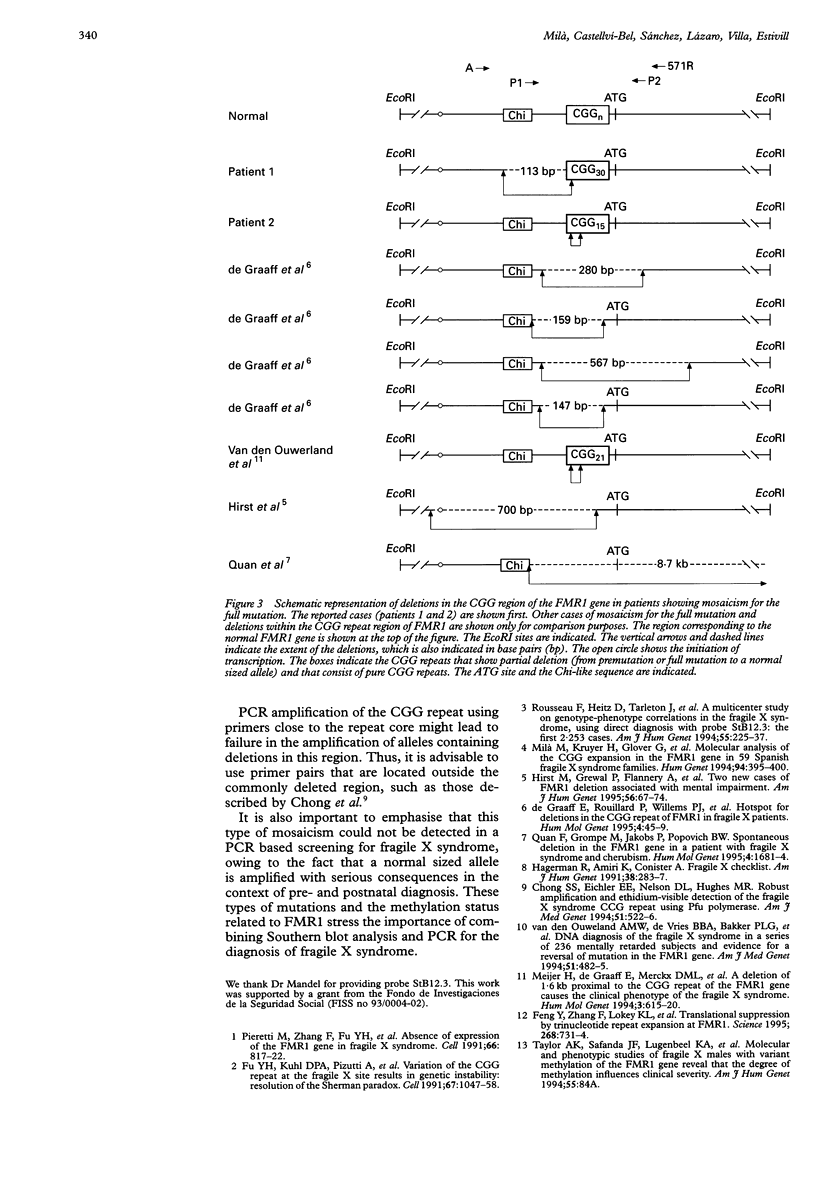Abstract
The main mutation responsible for the fragile X syndrome is the expansion of an untranslated CGG repeat in the first exon of the FMR1 gene, associated with the hypermethylation of the proximal CpG island and the CGG repeat region, and repression of transcription of FMR1. Fragile X syndrome mosaicism has been described as the coexistence of the full mutation and the permutation. We present here two cases of mosaicism for the full mutation in the FMR1 gene and deletions involving the CGG repeat region. In one case the deletion removed 113 bp proximal to the CGG repeat and part of the repeat itself, leaving 30 pure repeats, and representing 17% of lymphocytes of the patient. The 5' breakpoint of this deletion falls outside the putative hotspot for deletions in the CGG region of FMR1. In the second case the deleted region only involved the CGG sequence (leaving 15 pure repeats), with normal sequences flanking the repeat; this deleted ("normal") FMR1 was estimated to be in about 31% of blood lymphocytes. This second case can be considered a true regression of the CGG FMR1 expansion to a normal sized allele, although in mosaic form.
Full text
PDF


Images in this article
Selected References
These references are in PubMed. This may not be the complete list of references from this article.
- Chong S. S., Eichler E. E., Nelson D. L., Hughes M. R. Robust amplification and ethidium-visible detection of the fragile X syndrome CGG repeat using Pfu polymerase. Am J Med Genet. 1994 Jul 15;51(4):522–526. doi: 10.1002/ajmg.1320510447. [DOI] [PubMed] [Google Scholar]
- Feng Y., Zhang F., Lokey L. K., Chastain J. L., Lakkis L., Eberhart D., Warren S. T. Translational suppression by trinucleotide repeat expansion at FMR1. Science. 1995 May 5;268(5211):731–734. doi: 10.1126/science.7732383. [DOI] [PubMed] [Google Scholar]
- Fu Y. H., Kuhl D. P., Pizzuti A., Pieretti M., Sutcliffe J. S., Richards S., Verkerk A. J., Holden J. J., Fenwick R. G., Jr, Warren S. T. Variation of the CGG repeat at the fragile X site results in genetic instability: resolution of the Sherman paradox. Cell. 1991 Dec 20;67(6):1047–1058. doi: 10.1016/0092-8674(91)90283-5. [DOI] [PubMed] [Google Scholar]
- Hagerman R. J., Amiri K., Cronister A. Fragile X checklist. Am J Med Genet. 1991 Feb-Mar;38(2-3):283–287. doi: 10.1002/ajmg.1320380223. [DOI] [PubMed] [Google Scholar]
- Hirst M., Grewal P., Flannery A., Slatter R., Maher E., Barton D., Fryns J. P., Davies K. Two new cases of FMR1 deletion associated with mental impairment. Am J Hum Genet. 1995 Jan;56(1):67–74. [PMC free article] [PubMed] [Google Scholar]
- Meijer H., de Graaff E., Merckx D. M., Jongbloed R. J., de Die-Smulders C. E., Engelen J. J., Fryns J. P., Curfs P. M., Oostra B. A. A deletion of 1.6 kb proximal to the CGG repeat of the FMR1 gene causes the clinical phenotype of the fragile X syndrome. Hum Mol Genet. 1994 Apr;3(4):615–620. doi: 10.1093/hmg/3.4.615. [DOI] [PubMed] [Google Scholar]
- Milà M., Kruyer H., Glover G., Sánchez A., Carbonell P., Castellví-Bell S., Volpini V., Rossell J., Gabarrón J., López I. Molecular analysis of the (CGG)n expansion in the FMR-1 gene in 59 Spanish fragile X syndrome families. Hum Genet. 1994 Oct;94(4):395–400. doi: 10.1007/BF00201600. [DOI] [PubMed] [Google Scholar]
- Pieretti M., Zhang F. P., Fu Y. H., Warren S. T., Oostra B. A., Caskey C. T., Nelson D. L. Absence of expression of the FMR-1 gene in fragile X syndrome. Cell. 1991 Aug 23;66(4):817–822. doi: 10.1016/0092-8674(91)90125-i. [DOI] [PubMed] [Google Scholar]
- Quan F., Grompe M., Jakobs P., Popovich B. W. Spontaneous deletion in the FMR1 gene in a patient with fragile X syndrome and cherubism. Hum Mol Genet. 1995 Sep;4(9):1681–1684. doi: 10.1093/hmg/4.9.1681. [DOI] [PubMed] [Google Scholar]
- Rousseau F., Heitz D., Tarleton J., MacPherson J., Malmgren H., Dahl N., Barnicoat A., Mathew C., Mornet E., Tejada I. A multicenter study on genotype-phenotype correlations in the fragile X syndrome, using direct diagnosis with probe StB12.3: the first 2,253 cases. Am J Hum Genet. 1994 Aug;55(2):225–237. [PMC free article] [PubMed] [Google Scholar]
- de Graaff E., Rouillard P., Willems P. J., Smits A. P., Rousseau F., Oostra B. A. Hotspot for deletions in the CGG repeat region of FMR1 in fragile X patients. Hum Mol Genet. 1995 Jan;4(1):45–49. doi: 10.1093/hmg/4.1.45. [DOI] [PubMed] [Google Scholar]
- van den Ouweland A. M., de Vries B. B., Bakker P. L., Deelen W. H., de Graaff E., van Hemel J. O., Oostra B. A., Niermeijer M. F., Halley D. J. DNA diagnosis of the fragile X syndrome in a series of 236 mentally retarded subjects and evidence for a reversal of mutation in the FMR-1 gene. Am J Med Genet. 1994 Jul 15;51(4):482–485. doi: 10.1002/ajmg.1320510437. [DOI] [PubMed] [Google Scholar]




